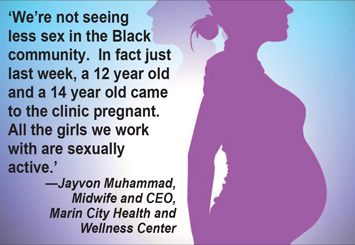Teen Births Down But Still Too High Among Blacks, Latinos
By Nisa Islam Muhammad -Staff Writer- | Last updated: May 11, 2016 - 9:41:16 AMWhat's your opinion on this article?

Graphic: MGN Online
|
“It’s really a one-two punch,” says CDC study co-author Shanna Cox, associate director for science for the CDC’s Division of Reproductive Health. “Teens are having less sex, and among the teens who are having sex, they’re using more effective methods of birth control.”
The report which was released April 28 highlighted the following:
-Dramatic racial and ethnic differences: In some states, birth rates among Hispanic and Black teens were more than three times as high as those of Whites.
-Socioeconomic and education gaps: Higher unemployment and lower income and education are more common in communities with the highest teen birth rates, regardless of race.
-Key in-state differences: In some states with low overall birth rates, pockets of high birth rates exist in some counties.
-Regional patterns: Counties with higher teen birth rates were clustered in Southern and Southwestern states.
“The United States has made remarkable progress in reducing both teen pregnancy and racial and ethnic differences, but the reality is, too many American teens are still having babies,” said CDC Director Tom Frieden, M.D., M.P.H.
“By better understanding the many factors that contribute to teen pregnancy we can better design, implement, evaluate, and improve prevention interventions and further reduce disparities.”
According to the CDC National Vital Statistics Report’s final birth data for 2014, a total of 3,988,076 births were registered in the United States in that year, up one percent from 2013. The number of births rose among each of the largest race and Hispanic origin groups (non-Hispanic White, non-Hispanic Black, and Hispanic women) from 2013 to 2014.
On the West Coast in Oakland, at the Marin City Health and Wellness Center, Midwife and CEO Jayvon Muhammad sees the problem up close and personal.
“The numbers of teen births are going down because girls have greater access to birth control. However, they are still engaging in too much risky sex. They are interested in long acting reversible birth control that lasts for months versus taking a pill every day,” she told The Final Call.
“We’re not seeing less sex in the Black community. In fact just last week, a 12 year old and a 14 year old came to the clinic pregnant. All the girls we work with are sexually active,” said Ms. Muhammad.
In the new report, CDC researchers analyzed national and state data from the National Vital Statistics System (NVSS) to examine trends in births to American teens’ ages 15 to 19 years between 2006 and 2014. Researchers highlight the importance of teen pregnancy prevention interventions that address socioeconomic conditions like unemployment and lower education levels, for reducing disparities in teen birth rates.
“These data underscore that the solution to our nation’s teen pregnancy problem is not going to be a one-size-fits-all – teen birth rates vary greatly across state lines and even within states,” said Lisa Romero, Dr. PH., a health scientist in CDC’s Division of Reproductive Health and lead author of the analysis.
“We can ensure the success of teen pregnancy prevention efforts by capitalizing on the expertise of our state and local public health colleagues. Together, we can work to implement proven prevention programs that take into account unique, local needs.”
Research has shown that teen pregnancy and childbirth cost U.S. taxpayers an estimated $9 billion each year and has negative health and social consequences.
Part of the problem according to Ms. Muhammad is parents. “There needs to be a shift in the culture of parenting. We have to protect our girls instead of passively giving them permission to be sexually active. A mom brought her 13 year old daughter to the clinic for Depo Prevara, an injection form of birth control. I asked her why she was bringing her in for this since her daughter wasn’t sexually active and was so young.”
“She said that she just wanted to be safe. We don’t even tell our girls not to have sex. There has to be a cultural shift that raises our expectations of them. The law in California says that girls 12 and up must have access to reproductive services. I ask parents everywhere if they want their 12 year old being sexually active. They all say no.”
Preventing teen pregnancy remains one of the CDC’s top priorities and the agency is working on a number of fronts that includes encouraging community-centered efforts. The Marin City Clinic is a good example of those efforts. The program works with teens to reduce their opportunities for risky behavior and increase their ability to make better life decisions.
Each summer they take a month long cross country trip with teens that may have never left the city and expose them to a variety of diverse experiences.
INSIDE STORIES AND REVIEWS
-
-
About Harriett ... and the Negro Hollywood Road Show
By Rabiah Muhammad, Guest Columnist » Full Story -
Skepticism greets Jay-Z, NFL talk of inspiring change
By Bryan 18X Crawford and Richard B. Muhammad The Final Call Newspaper @TheFinalCall » Full Story -
The painful problem of Black girls and suicide
By Charlene Muhammad -National Correspondent- » Full Story -
Exploitation of Innocence - Report: Perceptions, policies hurting Black girls
By Charlene Muhammad -National Correspondent- » Full Story -
Big Ballin: Big ideas fuel a father’s Big Baller Brand and brash business sense
By Bryan Crawford -Contributing Writer- » Full Story






 Click Here Stay Connected!
Click Here Stay Connected!








